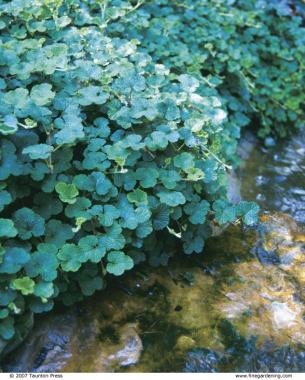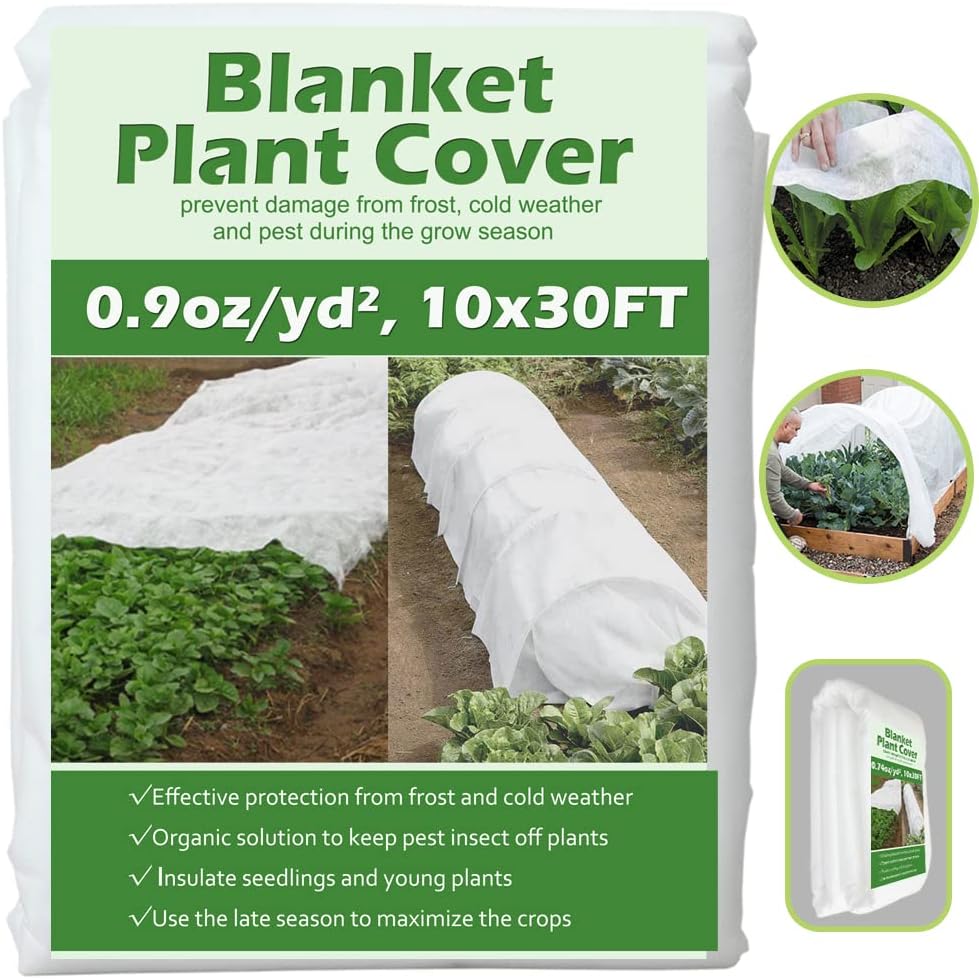
Sometimes it seems that designing a garden is like solving a complex puzzle. That’s actually one of the challenges of gardening I enjoy most—finding beautiful and robust plants to suit a site. And, in areas that can be the most confounding—such as along slopes, under trees, or between crevices of rocks or stepping stones—herbaceous ground covers often fill the bill.
My favorite ground-cover plants spread quickly without aggressively taking over the way that English ivy (Hedera helix) does. And they look stunning with little care. A few vigorous ground covers can even withstand foot traffic or the rowdy antics of pets.
Most great ground covers are essentially creepers—they grow out rather than up. Some, such as creeping raspberry (Rubus calycinoides, also known as Rubus pentalobus), travel by sending out runners and producing rootlets wherever a leaf node or stem touches the soil. Others, like Mazus reptans, form rosettes of foliage with roots along their stems. They’re all easy to propagate by division. None of my favorites develop woody stems or deep root systems, so they are relatively easy to curtail. If they cover too much ground, I just dig up the excess growth and either transplant it, give it away, or discard it.
Some creepers love the sun

Golden creeping thyme (Thymus X citriodorus “Aureus’) looks dainty, but it’s a tough and fast-growing ground cover. I use it to rapidly fill in gaps between stepping stones or rocks. It grows to only 2 or 3 inches high with tiny leaves about 14 inch wide and long. In early summer it bears small, delicate, whitish flowers. Mostly evergreen, the foliage starts with strong golden overtones and turns greener in autumn. In winter the stems take on reddish tinges. Like other thymes, golden creeping thyme is aromatic, releasing a slight lemony scent when touched, and can be used in cooking.
Another robust creeper, golden oregano (Origanum vulgare ‘Aureum‘) holds its golden hue best in colder weather. A useful culinary herb, golden oregano has tiny, rounded leaves 1/2 to 1 inch wide. Its small, lavender to purple flowers stand out above the foliage in early to late summer. Combine it with other oreganos, or plant it under lavenders (Lavendula spp.), rosemary (Rosemarinus officinalis), or Japanese bloodgrass (Imperata cylindrica ‘Red Baron’) to provide a contrasting carpet of gold.

These spreaders are at home in either sun or shade

If you want to test a plant’s toughness, try growing it in the strip between the sidewalk and the street. That’s where I’m using creeping raspberry as a ground cover. So far, it’s proved itself a worthy roadside warrior in my yard, where it has managed to survive abuse from both two-legged and four-legged creatures. It’s also a good alternative to creeping junipers along a steep slope. Quick to spread, its brown hairy stems put down roots wherever they touch the soil.
Evergreen in my Atlanta garden, creeping raspberry has rough, thick textured leaves that are rounded with irregular edges. Up to 1-1/2 inches in diameter, they start out rich green in spring. When cool fall weather arrives, some leaves take on tinges of orange, red, and then bronze, persisting through the winter. The underside of the leaves look as if they’ve been spray-painted bronze.
When I think of Australian plants, I conjure images of rugged, robust survivors. While blue star creeper (Laurentia fluviatilis), a native of Australia, is tough and easy to grow, it boasts a sweet and diminutive appearance that reminds me of baby’s tears (Soleirolia soleirolii). On and off during spring and summer, delicate, sky-blue, star-shaped flowers appear amid tiny, bright-green leaves that are usually less than 14 inch wide. Blue star creeper makes an attractive ground cover under trees and between stepping stones.
For the impatient gardener, Mazus reptans fills in quickly, but is well-behaved. It hugs the ground to form a tight carpet. In spring, tiny snapdragon-like blooms give the effect of a miniature flower garden. Blue or white with yellow markings, the blossoms rise up 2 to 4 inches above the foliage. Its many fibrous roots make it easy to propagate by division. Use this hardy perennial where its aggressive qualities can be appreciated, such as between stepping stones or to cover large patches of soil. For an alluring combination, plant Mazus reptans along the edge of a pond with cardinal flower (Lobelia cardinalis).
Other ground covers show off best in the shade

Photo/Illustration: Steve Silk
If you’re looking for a rugged plant that will thrive even in boggy areas, try golden creeping Jenny (Lysimachia nummularia ‘Aurea’). Also known as gold moneywort, this moisture lover puts out roots all along its stems so that large areas of ground are covered very quickly. Although the species is an aggressive grower in some areas, I’ve found that this cultivar is more wellbehaved. Even so, you may want to curb its growth by creating barriers.
Golden creeping Jenny is also a good creeper to choke out weeds. Its shiny, rounded, yellow-green leaves light up an area and contrast well with dark-colored herbaceous plants like Arum italicum ‘Pictum’ and ‘Palace Purple’ alum root (Heuchera micrantha var. diversifolia ‘Palace Purple’).
More of a leaper than a creeper, ‘Eco-Lacquered Spider’ green-and-gold (Chrysogonum virginianum ‘Eco-Lacquered Spider’) is an outstanding new selection of this native species. It stands out with rosettes of blue-green, metallic-looking leaves, and small, daisylike flowers about an inch in diameter. In winter, the foliage takes on tinges of purple. A fast grower, a one-gallon plant will cover an area five times as large in a single growing season. It sends out long, above-ground stolons that touch down and take root. For a stunning combination, plant ‘Eco-Lacquered Spider’ green-and-gold next to the charming, native dwarf crested iris (Iris cristata), which blooms around the same time.
Another fine candidate for the woodland is peacock moss (Selaginella uncinata). With its tiny, fernlike, aquamarine-blue leaves, this plant looks almost prehistoric to me. Vigorous but not invasive, peacock moss forms tight mats of foliage that reach only 4 to 6 inches tall. This semi-evergreen perennial grows happily in combination with hellebores and ferns.
It’s easy to get ground covers growing
Ground-cover plantings are relatively easy to establish, whether you use seedlings, divisions, or rooted cuttings. Once you select an area to plant, prepare the soil in advance.
Since all the plants described in this article spread rather quickly, plant 2- to 3-inch seedlings or divisions on 6-inch centers. Apply a light layer of mulch to retain moisture and discourage weeds. Water new plantings daily until they become established, and then water according to the plant’s moisture needs.
Growing your favorite ground covers


BLUE STAR CREEPER
Botanical name: Laurentia fluviatilis
Range: USDA Hardiness Zones 7 to 10
Culture: Grow in moist, welldrained soil in either full sun or partial shade. Plant divisions or rooted cuttings in the spring.
CREEPING RASPBERRY
Botanical name: Rubus calycinoides (also known as R. pentalobus)
Range: Zones 7 to 9
Culture: Plant in full sun or partial shade in well-drained soil. Cut off and transplant pieces of stems where roots have formed any time in the growing season.
‘ECO-LACQUERED SPIDER’ GREEN-AND-GOLD
Botanical name: Chrysogonum virginianum ‘Eco-Lacquered Spider’
Range: Zones 5 to 8
Culture: While it’s happiest in dappled shade, such as along woodland edges, it will also adapt to sunnier spots if it’s watered during periods of drought. Plant divisions or rooted stem cuttings in the spring. In warmer climates, you can also plant in the fall.
GOLDEN CREEPING JENNY
Botanical name: Lysimachia nummularia ‘Aurea’
Range: Zones 4 to 8
Culture: This moisture lover also adapts to dry soil. To encourage the brightest foliage, site this prostrate perennial where it gets morning sun but is shaded during the hottest part of the day. Plant divisions or rooted cuttings any time during the growing season.
GOLDEN OREGANO
Botanical name: Origanum vulgare ‘Aureum’
Range: Zones 5 to 9
Culture: Give this spreader lots of sun and good drainage. Plant divisions or rooted cuttings in the spring.
GOLDEN CREEPING THYME
Botanical name: Thymus X citriodorus ‘Aureus’
Range: Zones 6 to 9
Culture: Native to the Mediterranean, it grows best in full sun and will endure only in well-drained soil. Amend average soil with sharp sand or course gravel to ensure good drainage. Plant divisions or rooted cuttings in the spring. Regular shearing improves air circulation and reduces fungal problems. Even when small sections of this ground cover die out, it bounces back quickly.

MAZUS REPTANS
Botanical name: Mazus reptans
Range: Zones 5 to 8
Culture: Plant it in shade for the best performance, but it also grows well in full sun as long as it’s in moist soil. Plant divisions any time in the growing season or rooted cuttings in the spring.
PEACOCK MOSS
Botanical name: Selaginella uncinata
Range: Zones 7 to 11
Culture: Grow in moist woodland soil. Transplant pieces of stems where roots have formed any time in the growing season, or plant divisions in the spring. If the frondlike tips dry out or die back in winter, simply cut them back in early spring to expose the colorful new growth.
Fine Gardening Recommended Products

Corona E-Grip Trowel
Fine Gardening receives a commission for items purchased through links on this site, including Amazon Associates and other affiliate advertising programs.

Ho-Mi Digger - Korean Triangle Blade
Fine Gardening receives a commission for items purchased through links on this site, including Amazon Associates and other affiliate advertising programs.

Plant Covers Freeze Protection 10 ft x 30 ft Floating Row Cover 0.9oz/yd²
Fine Gardening receives a commission for items purchased through links on this site, including Amazon Associates and other affiliate advertising programs.


















Comments
Is creeping myrtlyl in the pine family & can I grow any creepinng pine in north west N. J/?
We have had Lysimachia nummularia spread through our lawn, into our native area, and into a brook, where it is now happily taking over native plant communities. It takes HUGE amounts of time trying to keep this and creeping charlie in check. Both came from hanging baskets from the previous owner (who expressed deep regret for introducing them). The gold form does not grow as fast and I have seen cases where it reverts to green. It should be contained, the blooms removed to prevent seeding, and pieces will readily break off and root. Be extra careful with your garden waste. Investigate every plant you bring to your property by searching its scientific name + invasive + your area, and a couple of areas with similar climates. If you come up positive and make a responsible choice, pat yourself on the back...you have just kept part of the world its normal wonderful self.
I'd like a small variegated grass to plant along the border of my walkway garden in zone 5 b... any ideas will be welcome, thank you.
This is an awesome list of invasive plants. Oh wait, these are planting recommendations. Hmm.
Log in or create an account to post a comment.
Sign up Log in